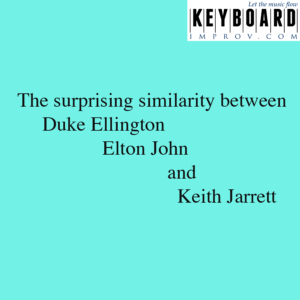
What do Duke Ellington, Keith Jarrett, and Elton John have in common?
At first glance it may seem that these three great musicians don’t really have a lot in common at all, except for the fact that they all play(ed) the piano. But what fascinates me is that there was a brief period in the early 1970s when their styles merged in a very real way.
Let’s start by listening to the first few seconds of an early 1970s recording by each of them. Just “take in” the overall sound of these performances:
Duke Ellington: The African Flower (start listening at 1:12)
Keith Jarrett: The Köln Concert, Part 2c
Elton John: Daniel (This is actually from a more recent performance, where the piano part is clearly heard. Start listening at :56)
Do you notice how much the 3 songs have in common?
All three pianists are playing music that contains straight 8th notes at a moderate tempo. Going deeper, the music is all relaxed, pleasant, and very much related to the folk-like lite pop/rock music that was popular at the time. (Yes, I know that Ellington wrote “The African Flower” earlier, in the 1950s. But he was always well aware of what was happening in pop music at the time and he tended to give his audience what they wanted to hear. Indeed, much of this entire performance was “non-swing” music and some of it even used pure triads instead of jazz harmony. I think in this case, his own personal self-expression at this point in his life coincided with this type of music.)
There are some very specific rhythmic and harmonic similarities between the pieces as well. For example, all 3 pieces begin by staying on the tonic chord for about 2 measures, which gives a stable sense of tonic which the groove is being established. And this grooves themselves are almost identical among the three as well. They all use a similar syncopation that’s basically “8th note, quarter, quarter, quarter, 8th note.” (Sing that and you’ll hear it.) In Ellington’s case, this rhythm is in his left hand pattern. Jarrett’s melody uses almost the same exact rhythm (except for the quarter note on the first beat), and Elton John implies this rhythmic “floating” in his the right hand comping of his electric piano part throughout the whole song.
I’m not saying that Ellington, Jarrett, and John always played the same type of music. Not at all. Rather, I’m noticing that one of Elton John’s breakthrough hits, a famous moment on the album that made Jarrett a star, and the piece that Ellington chose to begin a TV performance with are astonishingly similar. And furthermore, they reflect the larger popular music scene at the time.
This observation could lead us to a larger study of how music in different genres share overall similarities relating to the culture of a given time period that transcend the specific musical styles at hand. For instance, have you ever noticed how in the avant garde acoustic jazz of John Coltrane reflects the same late-1960s cultural energy that Jim Hendrix’s electric rock music does? It’s not totally surprising when you realize that Hendrix listened to Coltrane and that jazz musicians like Miles Davis and Gil Evans in turn listened to Hendrix. And one of the reasons they could relate to each other’s music is that they all were in tune with the cultural vibe of the day.
Seen in this light, it’s not really that surprising that Duke Ellington, Keith Jarrett, and Elton John all played some similar music in the early 1970s. They were all great musicians who “kept an ear to the ground” and were in tune with the larger world around them.
If you’re interested in Duke Ellington’s “The African Flower,” check out:
African Flower (from The Jazz Pianist’s Ultimate Guide To The Real Book)
Learn the 5 Essential Left Hand Techniques with my free ebook: Left Hand Techniques for Jazz Piano
You’ll also get my weekly jazz newsletter with practice tips and inspiration

